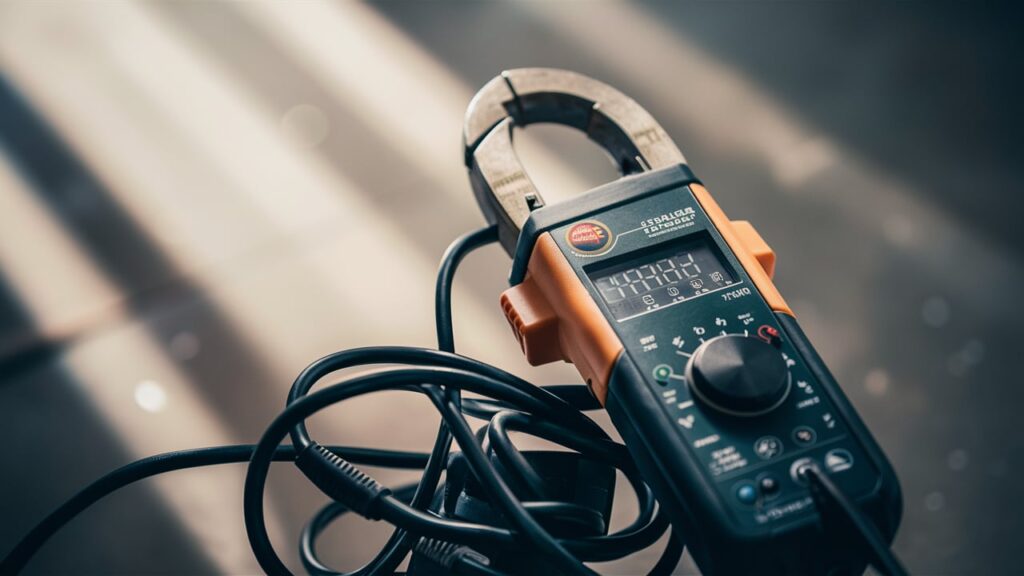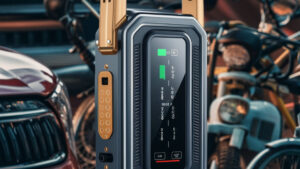A clamp meter works by measuring the magnetic field around a conductor to determine the current flowing through it. This is done by clamping the jaws of the meter around the conductor, which induces a magnetic field that can be measured.
A clamp meter is a versatile electrical testing tool used by electricians and technicians to measure current without the need to disconnect the circuit being tested. This non-invasive method of measurement makes it a safe and convenient tool for troubleshooting electrical systems.
By understanding how a clamp meter works, users can accurately and safely measure current in various applications, making it an essential tool for professionals working with electrical systems.
Introduction To Clamp Meters
The Basics Of Electrical Measurement
Clamp meters measure electrical current without breaking the circuit.
Evolution Of Clamp Meters
Clamp meters have evolved from traditional multimeters to cater to modern needs.
Key Components Of A Clamp Meter
A clamp meter is a handheld device used to measure electrical current in a conductor without the need to disconnect it. The device uses a clamp sensor technology, which allows it to measure current by clamping onto the conductor without making contact with it. The key components of a clamp meter include the clamp sensor, display, function buttons, and measurement range selector.
Clamp Sensor Technology
The clamp sensor is the most important component of a clamp meter. It is responsible for measuring the current flowing through the conductor. The clamp sensor works on the principle of electromagnetic induction. When a conductor carrying current is placed inside the clamp sensor, it generates a magnetic field. The clamp sensor detects this magnetic field and converts it into an electrical signal, which is then displayed on the meter.
The Role Of Hall Effect Sensors
The clamp sensor contains a Hall effect sensor, which is responsible for detecting the magnetic field generated by the conductor. The Hall effect sensor is a semiconductor device that produces a voltage proportional to the magnetic field. This voltage is then amplified and processed by the meter to display the current reading. The use of Hall effect sensors in clamp meters makes them more accurate and reliable than other types of current measuring devices.
In conclusion, the key components of a clamp meter include the clamp sensor, display, function buttons, and measurement range selector. The clamp sensor technology and the use of Hall effect sensors make clamp meters highly accurate and reliable devices for measuring electrical current in a conductor.
Principles Behind Clamp Meter Functionality
Clamp meters work by measuring electromagnetic field variations around a current-carrying conductor. They utilize induction principles to detect current flow without physical contact. This non-invasive method ensures accurate readings without interrupting the circuit under test.
Clamp meters are essential tools for electricians and technicians, allowing them to measure current without breaking the circuit. Understanding the principles behind clamp meter functionality is crucial for using this device effectively. In this section, we will explore two key aspects: magnetic induction and current measurement, as well as the process of transforming voltage to digital readings.
Magnetic Induction And Current Measurement
Magnetic induction lies at the core of how clamp meters operate. When an electric current flows through a conductor, it generates a magnetic field around it. The clamp meter’s jaws are designed with a magnetic core that can detect and measure this magnetic field.
By clamping the jaws around the conductor, the magnetic field induces a voltage in the core. This induced voltage is then converted into a current measurement, which is displayed on the meter’s screen. The strength of the magnetic field determines the magnitude of the current being measured.
Transforming Voltage To Digital Readings
To obtain accurate current readings, clamp meters must transform the induced voltage into digital measurements. This transformation involves several steps.
First, the induced voltage is converted into a proportional current signal using a transducer. This current signal is then amplified to a level suitable for further processing.
Next, an analog-to-digital converter (ADC) is employed to convert the amplified current signal into digital data. The ADC samples the signal at regular intervals and assigns a numerical value to each sample.
Finally, the digital data is processed by the meter’s microcontroller, which performs calculations to provide accurate current readings. The processed information is then displayed on the meter’s screen, allowing users to interpret and analyze the measurements.
In conclusion, the principles behind clamp meter functionality rely on magnetic induction to measure current and the transformation of induced voltage into digital readings. Understanding these principles is essential for utilizing clamp meters effectively and obtaining accurate measurements in electrical applications.
Types Of Clamp Meters
Analog Versus Digital Clamp Meters
Analog clamp meters use a needle to display the measured current, whereas digital clamp meters provide readings on a digital screen.
Specialized Clamp Meters For Advanced Applications
Specialized clamp meters are designed for specific applications such as high-current measurements, power quality analysis, and HVAC systems.
Safety Precautions And Best Practices
Discover safety precautions and best practices for using a clamp meter. Learn how this device works to measure electrical current safely and accurately. Following proper guidelines ensures accurate readings and prevents potential hazards.
Ensuring Accurate Measurements
When using a clamp meter, it is important to follow certain safety precautions and best practices to ensure accurate measurements. By doing so, you can avoid potential hazards and obtain reliable data for your electrical troubleshooting or maintenance tasks.
Here are some key steps to consider:
1. Select the appropriate range: Before taking any measurements, make sure to set the clamp meter to the correct range for the expected current. This ensures accurate readings and prevents potential damage to the device.
2. Position the clamp correctly: When using a clamp meter, position the clamp around only one conductor at a time. This allows the meter to measure the current flowing through that specific conductor without interference from other nearby wires.
3. Ensure a secure connection: To obtain accurate measurements, ensure that the clamp meter has a firm and secure connection to the conductor. Loose connections may introduce errors or fluctuation in readings, leading to inaccurate data.
4. Avoid magnetic fields: Magnetic fields can affect the readings of a clamp meter. Therefore, it is important to keep the meter away from strong magnetic fields or other devices that may generate electromagnetic interference.
Avoiding Common Mistakes
To make the most of your clamp meter and ensure accurate measurements, it is essential to avoid common mistakes that can compromise the integrity of your data. By being aware of these pitfalls, you can enhance the reliability of your measurements.
Here are some common mistakes to avoid:
1. Incorrect positioning: Ensure that the clamp is properly positioned around the conductor. Placing it too close to a nearby wire or too far from the target conductor can lead to inaccurate readings.
2. Neglecting zeroing: It is crucial to zero or null the clamp meter before taking measurements. This compensates for any residual magnetism or offset, ensuring accurate readings.
3. Failure to account for conductor size: When using a clamp meter, take into account the size of the conductor being measured. Different clamp meters have different jaw sizes, so ensure that the meter you are using can accommodate the conductor you are working with.
4. Not following manufacturer instructions: Always refer to the manufacturer’s instructions and guidelines specific to your clamp meter model. Each meter may have unique features and usage guidelines that should be followed for accurate measurements.
By adhering to these safety precautions and best practices, you can effectively use a clamp meter and obtain accurate measurements without compromising your safety or the integrity of your data. Remember to prioritize safety, double-check your connections, and follow the manufacturer’s instructions to make the most of your clamp meter.
Understanding The Clamp Meter Readings
A clamp meter measures electrical current by clamping around a wire, making it a safe and convenient tool for electricians. It works based on the principle of electromagnetic induction, allowing it to display accurate readings without needing to physically touch the live conductor.
Understanding these readings is crucial for diagnosing electrical issues and ensuring safety.
Interpreting The Display
Troubleshooting Inconsistent Results
Applications Of Clamp Meters In Various Industries
Clamp meters are versatile tools used across different industries for measuring electrical current without the need to disconnect the circuit. Let’s explore how these instruments are utilized in various sectors.
Electrical And Electronics Sector
In the electrical industry, clamp meters are essential for testing current flow in wires and cables. They help diagnose electrical issues quickly and accurately.
Hvac And Refrigeration System Maintenance
For HVAC technicians, clamp meters are valuable for checking compressor motor currents and verifying system efficiency. In refrigeration, they aid in monitoring power consumption and diagnosing faults.
Advances In Clamp Meter Technology
Clamp meters have undergone significant technological advancements, revolutionizing the way they work. These devices utilize a unique design that allows them to measure current without the need for direct contact, making them safe and efficient tools for electricians and technicians alike.
Innovative Features In Modern Clamp Meters
The latest advancements in clamp meter technology have revolutionized how electricians and technicians measure current. Modern clamp meters come equipped with innovative features that enhance accuracy and efficiency.
- Wireless connectivity for remote monitoring
- Auto-ranging capabilities for seamless measurements
- Advanced filtering for noise reduction
The Future Of Clamp Meters
As technology continues to evolve, the future of clamp meters looks promising with even more cutting-edge features on the horizon. These advancements will further streamline current measurement processes and improve overall user experience.
- Integration with smart devices for data analysis
- Enhanced durability for rugged work environments
- AI-powered functions for predictive maintenance

Frequently Asked Questions
How Does A Clamp Meter Work?
A clamp meter works by measuring the magnetic field created by an electrical current passing through a conductor. The meter’s jaws are opened and clamped around the conductor, and the device measures the magnetic field to determine the current flowing through the conductor.
What Are The Advantages Of Using A Clamp Meter?
There are several advantages to using a clamp meter, including the ability to measure current without interrupting the circuit, the ability to measure AC and DC current, and the ability to measure current in hard-to-reach locations.
Can A Clamp Meter Measure Voltage?
Yes, some clamp meters have a built-in voltage measurement function that allows them to measure AC and DC voltage. However, it is important to note that clamp meters are not designed to measure voltage directly, and should only be used for voltage measurements in special circumstances.
How Do I Choose The Right Clamp Meter?
When choosing a clamp meter, consider factors such as the maximum current it can measure, the accuracy of its measurements, and any additional features it may have, such as the ability to measure voltage or resistance.
Conclusion
A clamp meter is a versatile tool that allows electricians and technicians to measure electrical current without the need to break the circuit. By clamping around the wire, it can detect and measure the magnetic field generated by the current flow.
With its ease of use and accurate readings, clamp meters have become an essential instrument in the field of electrical work. Understanding how a clamp meter works can greatly enhance efficiency and safety in various electrical applications.








